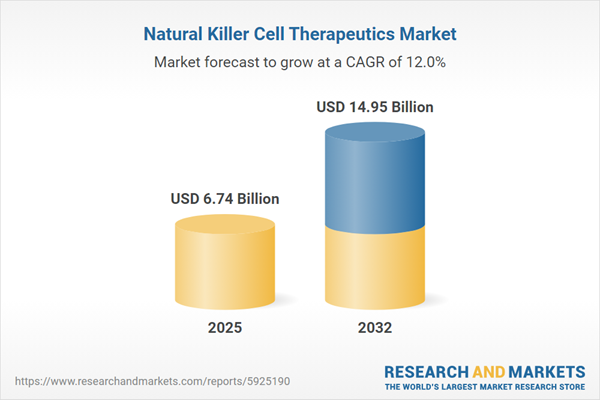Speak directly to the analyst to clarify any post sales queries you may have.
Natural killer cell therapeutics are reshaping the immuno-oncology landscape, providing executive decision-makers with innovative strategies to modernize healthcare delivery and enhance organizational readiness. These therapies represent an opportunity to strengthen clinical offerings and secure future market positioning in the evolving biologicals sector.
Market Snapshot: Natural Killer Cell Therapeutics Market
The natural killer cell therapeutics market is advancing steadily, propelled by increasing clinical integration of cell-based immunotherapy and heightened investment in research and emerging technologies. In 2024, the industry achieved a valuation of USD 6.02 billion, and forecasts indicate continued expansion to USD 6.74 billion in 2025 and USD 14.95 billion by 2032, reflecting a compound annual growth rate of 12.04 percent. This positive trajectory is underpinned by an expanding portfolio of therapeutic products, robust clinical development pipelines, and collaborative partnerships in global markets. Sector momentum is further driven by ongoing innovation in therapy development and streamlined delivery solutions, fostering long-term growth potential and improving access.
Scope & Segmentation
- Type: Allogeneic therapeutics are designed using universal donor cells, streamlining manufacturing workflows and promoting scalable clinical distribution. In parallel, autologous therapies enable tailored solutions specific to individual patients, driving advancements in hematological disorders and solid tumor indications.
- Indication: The primary applications for natural killer cell therapeutics encompass autoimmune diseases, a range of blood cancers such as leukemia and lymphoma, and major solid tumors including breast, lung, and ovarian cancers. Investigations are also exploring their role in novel infectious disease applications.
- Source: Therapy development leverages diverse cell sources, including established cell lines (for example, KHYG-1 and NK-92), induced pluripotent stem cells, and cells derived from peripheral or umbilical cord blood, expanding the functionality and innovation potential of next-generation treatments.
- End Users: Key end users are contract research organizations, specialty hospitals, oncology care centers, and translational research institutes, each contributing to expanded clinical adoption and technology translation within the healthcare system.
- Regions Covered: The report analyzes market opportunities across the Americas, Europe, Middle East and Africa, and Asia-Pacific, each shaped by unique regulatory structures, investment environments, and commercialization models, supporting targeted regional strategies.
- Key Companies Analyzed: Competitive assessment includes Fate Therapeutics, Nkarta Therapeutics, Allogene Therapeutics, Bristol-Myers Squibb, Gamida Cell, Takeda Pharmaceutical, Kyowa Kirin, Innate Pharma, Artiva Biotherapeutics, and Kiadis Pharma, focusing on product pipelines, strategic alliances, and go-to-market frameworks.
Key Takeaways for Senior Decision-Makers
- Natural killer cell therapeutics create adaptable pathways for linking cell therapy advancements with evolving care models, fostering alignment with long-term organizational objectives and risk mitigation planning.
- Ongoing improvements in regulatory standards provide greater transparency from development through commercialization, allowing organizations to make informed resource allocation and market launch decisions.
- Innovative manufacturing solutions, such as the adoption of closed-system bioreactors and modular process designs, enhance production scalability, operational resilience, and regulatory compliance within the supply chain.
- Cross-industry collaboration among biopharmaceutical companies, technology suppliers, and research institutions is shortening development timelines, reducing the path to clinical adoption of novel therapies.
- Adapting commercialization and pricing models to align with diverse regional reimbursement and healthcare delivery structures is critical for expanding patient access and maintaining sustained presence in priority markets.
Tariff Impact on Supply Chain and Market Accessibility
US-imposed trade tariffs introduce operational hurdles and limit market reach for natural killer cell therapy manufacturers. Many mid-sized and smaller entities are responding by localizing supply chains, enhancing financial oversight, and conducting scenario planning to maintain supply continuity. These responses help safeguard product availability and access to strategic markets, despite regulatory uncertainty.
Methodology & Data Sources
The findings presented in this report are built on comprehensive analysis of secondary research, including clinical trial result comparisons, intellectual property reviews, and monitoring of evolving regulatory frameworks. These data are augmented by direct input from industry executives and technical experts, resulting in actionable intelligence for confident strategic planning.
Why This Report Matters
- Equips executive leaders with in-depth market analysis, portfolio optimization guidance, and pragmatic approaches to uphold regulatory readiness while adapting to shifting patient needs and technology trends.
- Enhances business growth and competitive positioning through detailed competitor benchmarking and identification of emerging value opportunities within the sector.
- Offers structured frameworks for managing compliance challenges and driving technology adoption, supporting high-performance operations and robust market strategy execution.
Conclusion
This report delivers essential insight for organizational leaders aiming to capitalize on natural killer cell therapy innovation, enabling effective technology integration and promoting improved healthcare delivery outcomes.
Additional Product Information:
- Purchase of this report includes 1 year online access with quarterly updates.
- This report can be updated on request. Please contact our Customer Experience team using the Ask a Question widget on our website.
Table of Contents
3. Executive Summary
4. Market Overview
7. Cumulative Impact of Artificial Intelligence 2025
Companies Mentioned
The companies profiled in this Natural Killer Cell Therapeutics market report include:- Fate Therapeutics, Inc.
- Nkarta Therapeutics, Inc.
- Allogene Therapeutics, Inc.
- Bristol-Myers Squibb Company
- Gamida Cell Ltd.
- Takeda Pharmaceutical Company Limited
- Kyowa Kirin Co., Ltd.
- Innate Pharma S.A.
- Artiva Biotherapeutics, Inc.
- Kiadis Pharma N.V.
Table Information
| Report Attribute | Details |
|---|---|
| No. of Pages | 186 |
| Published | November 2025 |
| Forecast Period | 2025 - 2032 |
| Estimated Market Value ( USD | $ 6.74 Billion |
| Forecasted Market Value ( USD | $ 14.95 Billion |
| Compound Annual Growth Rate | 12.0% |
| Regions Covered | Global |
| No. of Companies Mentioned | 11 |









